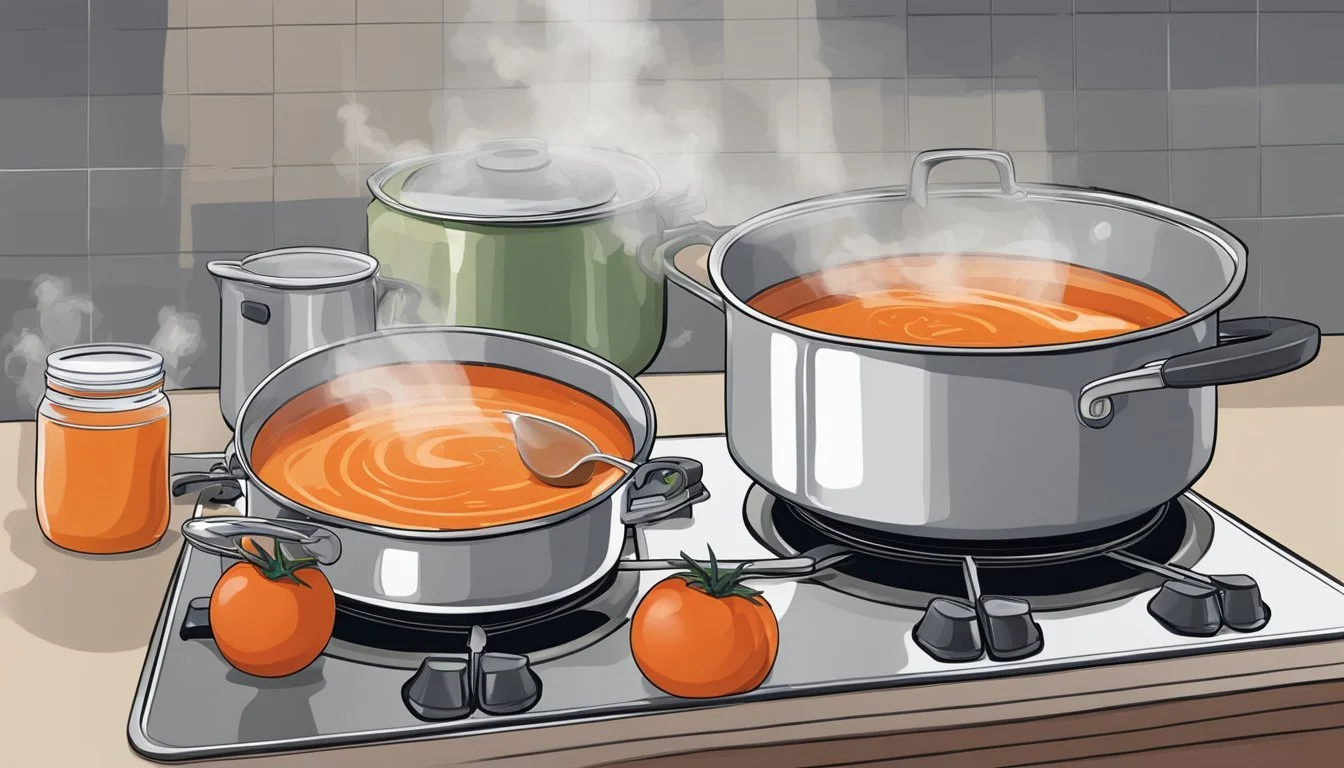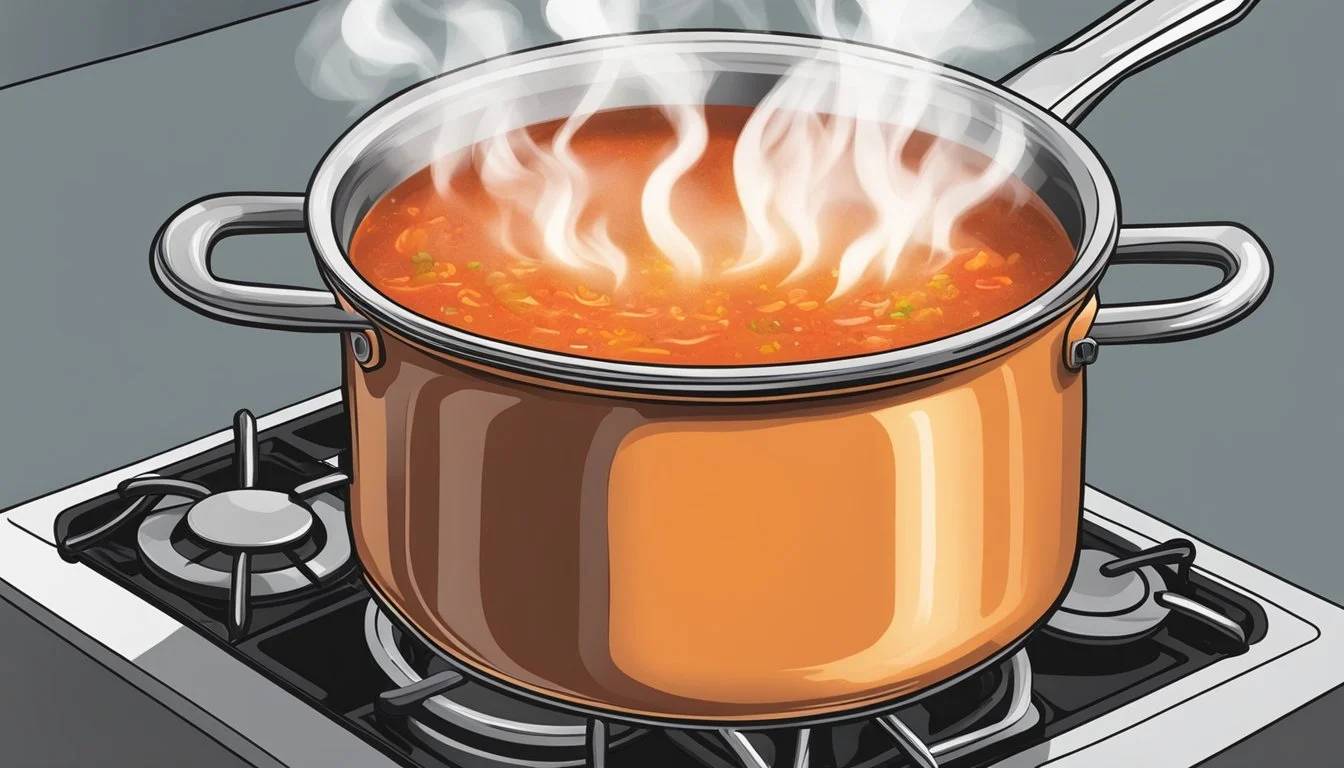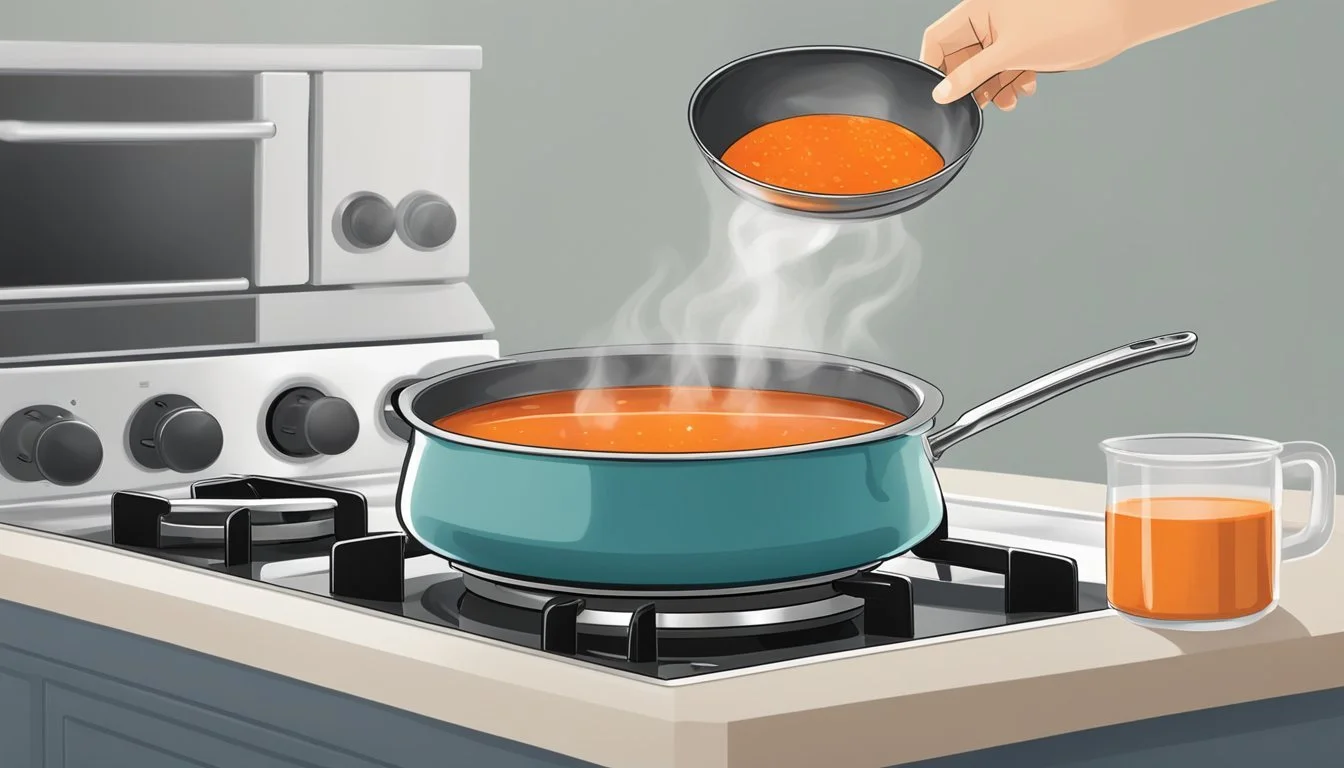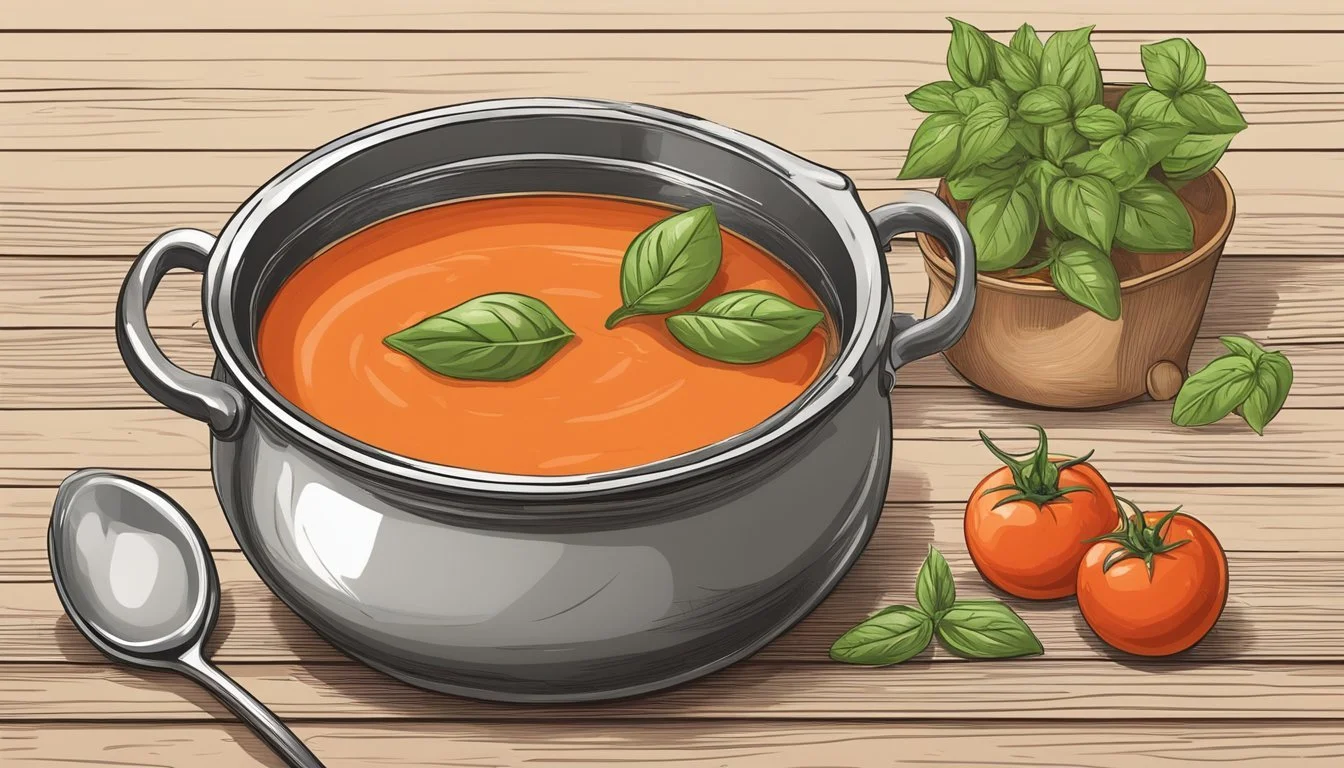How to Reheat Gluten-Free Tomato Soup
A Step-by-Step Guide
Finding the perfect way to reheat gluten-free tomato soup can ensure that it retains its delicious flavor and satisfying texture. To reheat gluten-free tomato soup effectively, gently warm it on the stove over medium-low heat while stirring occasionally to prevent scorching. This method preserves the soup's rich and smooth consistency, ensuring every spoonful is just as good as when it was freshly made.
For those in a hurry, the microwave offers a quick alternative. Place the soup in a microwave-safe container, cover it with a lid or microwave-safe wrap, and heat in short intervals while stirring in between to ensure even warming. This helps maintain the gluten-free recipe's integrity without compromising its taste or texture.
Ensuring that the soup is perfectly reheated will make it just as inviting and comforting as it was initially. Whether on the stove or in the microwave, taking these steps can help keep your gluten-free tomato soup delicious and ready to be enjoyed at any time.
Understanding Gluten-Free Tomato Soup
Gluten-free tomato soup is a nourishing and versatile dish suitable for many dietary preferences. Its variations include dairy-free and vegan options, as well as different methods of preparation that ensure it remains a staple for those avoiding gluten.
What Makes Soup Gluten-Free
A gluten-free soup avoids using any ingredients containing gluten, typically found in wheat, barley, and rye. Essential ingredients include fresh or canned tomatoes, vegetables like onions and carrots, and gluten-free broth.
It's crucial to check labels on pre-packaged ingredients like stock and spices to confirm they are gluten-free. Contamination can occur if the soup is prepared in a kitchen that also processes gluten-containing foods, so using dedicated utensils is vital.
Popular Gluten-Free Tomato Soup Variations
Gluten-free tomato soup can be twisted into many delicious variations to cater to different dietary needs. For a dairy-free option, substitute traditional cream with coconut milk or nut-based creamers. For those following a vegan lifestyle, using vegetable broth and omitting all animal products like butter is key.
Garnishes such as gluten-free croutons add a crunchy texture, enhancing the soup's appeal. Another popular pairing is gluten-free chicken noodle soup, which can be easily adapted by adding gluten-free pasta and shredded chicken to the tomato base for added protein and texture. This makes the meal heartier without compromising dietary restrictions.
Preparation of Gluten-Free Tomato Soup
Making gluten-free tomato soup starts with selecting fresh, high-quality ingredients and employing specific cooking techniques to ensure a safe and flavorful dish.
Selecting the Right Ingredients
Choosing the right ingredients is crucial for a delicious gluten-free tomato soup. Fresh tomatoes, preferably organic, provide the best flavor. Tomato paste helps to deepen the taste, while either chicken or vegetable broth adds a rich base. Check that all packaged items, such as broth and tomato paste, are labeled gluten-free to avoid cross-contamination.
Common ingredients include:
Olive oil
Fresh tomatoes
Tomato paste
Vegetable or chicken broth
Garlic cloves
Onions
Olive oil is often used to sauté garlic cloves and onions, enhancing the soup's overall flavor. Additionally, herbs like dried basil or oregano can be incorporated for extra aroma and taste.
Gluten-Free Cooking Techniques
Proper techniques are essential to maintain the gluten-free integrity of the soup. Start by heating olive oil in a large pot over medium heat. Add minced garlic cloves and finely chopped onions, cooking until fragrant. Once aromatic, add tomato paste and sauté briefly.
Next, add fresh, diced tomatoes, and allow them to cook for a few minutes. Pour in the gluten-free vegetable or chicken broth, stirring to combine. Bring the mixture to a boil, then reduce to a simmer.
If the recipe calls for creaminess, add either heavy cream or a dairy-free alternative like coconut milk. For a smoother texture, use an immersion blender. Ensure all utensils and cooking surfaces are clean and free from gluten contamination.
By carefully selecting ingredients and following specific cooking steps, anyone can create a delicious, safe gluten-free tomato soup.
How to Reheat Gluten-Free Tomato Soup
Reheating gluten-free tomato soup can be done effectively using various methods, each with its own advantages. Here, we cover reheating on the stovetop, using the oven, and microwave for safe and quick results.
Reheating on the Stovetop
Reheating on the stovetop is ideal for preserving the soup's texture and flavor.
Place the Soup in a Pot: Transfer the soup to a medium-sized pot.
Heat Slowly: Set the stove to medium-low heat. Gradually warm the soup, stirring occasionally to prevent sticking or burning.
Simmer: Allow the soup to reach a gentle simmer. This ensures the soup heats evenly without scorching.
Check Temperature: Use a food thermometer to confirm the soup reaches at least 165°F (74°C) to ensure it is safely heated for consumption.
This method helps maintain the soup's rich consistency and flavor.
Oven Reheating Method
Using the oven is useful if you have a larger quantity of soup to reheat.
Preheat the Oven: Set the oven to 350°F (175°C).
Use an Oven-Safe Dish: Pour the soup into an oven-safe dish and cover with foil to retain moisture.
Heat Thoroughly: Place the dish in the oven and heat for about 20-25 minutes.
Stir Midway: Halfway through, stir the soup to ensure even heating and to prevent the top layer from drying out.
Check Readiness: Ensure the soup reaches an internal temperature of 165°F (74°C) before serving.
This method is effective for reheating without compromising taste.
Microwaving Your Soup Safely
Microwaving is the quickest and most convenient way to reheat individual servings of soup.
Choose a Microwave-Safe Container: Transfer the soup to a microwave-safe bowl. Avoid metal containers.
Cover the Bowl: Cover the bowl with a microwave-safe lid or a damp paper towel to prevent splatters.
Heat in Intervals: Microwave on high for 1-2 minutes. Stir the soup halfway to promote even heating.
Check and Stir: After each interval, stir the soup and check the temperature. Continue until the soup reaches 165°F (74°C).
Let it Sit: Let the soup sit for a minute before serving to ensure an even temperature throughout.
This method is efficient and retains the soup's nutritional value.
Storing Gluten-Free Tomato Soup
Properly storing gluten-free tomato soup ensures it stays fresh and maintains its flavor. The key methods include refrigeration and freezing, each with specific guidelines.
Refrigeration Tips
When storing gluten-free tomato soup in the refrigerator, use an airtight container. This prevents any fridge odors from seeping in and keeps the soup fresh.
Store the soup in the fridge for up to 4-5 days. Before refrigerating, allow the soup to cool to room temperature. This step helps avoid raising the fridge’s internal temperature, reducing the risk of spoilage for other items.
Label the container with the date it was made. This helps track freshness and ensures the soup is consumed within the recommended time frame.
Freezing and Defrosting
For longer storage, place cooled gluten-free tomato soup in a freezer-safe container or ziplock bag. This approach prevents freezer burn and extends the soup's shelf life to up to 6 months.
To freeze, fill the container or bag, leaving some space at the top. The soup expands slightly as it freezes.
When ready to use, defrost the soup by transferring it to the fridge overnight. Alternatively, use the defrost setting on a microwave for quicker thawing.
Reheat the thawed soup in a pot over medium-low heat for 3-5 minutes, stirring occasionally until hot. This method ensures even heating without burning the soup.
Customizing Your Gluten-Free Tomato Soup
Customizing your gluten-free tomato soup enhances its flavor and allows it to cater to dietary preferences such as dairy-free and vegan options.
Incorporating Dairy-Free and Vegan Options
For those adhering to a dairy-free or vegan diet, there are numerous alternatives available. Coconut milk is a popular choice, providing a creamy texture without introducing dairy. It can replace cream or regular milk in most recipes without significantly changing the flavor profile.
Almond milk or soy milk are other viable options. These plant-based milks add a slight nutty flavor and help maintain the soup's richness. Some prefer using nutritional yeast for a cheese-like flavor, beneficial in vegan diets.
When using these alternatives, it's important to adjust the seasoning, as they can alter the soup's overall taste. Taste as you go and incorporate more salt, pepper, or herbs such as fresh basil to ensure the soup meets your flavor expectations.
Enhancing Flavors with Seasoning
Seasoning is key to transforming a basic tomato soup into a gourmet dish. Freshly cracked black pepper and a pinch of sea salt provide a good foundation. For a herbaceous twist, fresh basil or oregano can be added towards the end of cooking.
For those who enjoy a bit of heat, a dash of cayenne pepper or red pepper flakes can be a great addition. Garlic powder and onion powder are excellent for deepening the soup’s flavor profile without overpowering the tomato base.
Consider experimenting with different combinations of these seasonings. A touch of brown sugar can balance the acidity of the tomatoes, while smoked paprika adds a subtle smokiness. Always prioritize seasoning in small increments and taste frequently to achieve the perfect balance.
Serving Suggestions
To enhance gluten-free tomato soup, consider pairing it with complementary sides and presenting it in an appealing manner. Both accompaniments and presentation can elevate the dining experience, making the soup not only tastier but more enjoyable to eat.
Accompaniments for Gluten-Free Tomato Soup
Grilled cheese is a classic choice. Opt for gluten-free bread and a rich, melty cheese like cheddar or mozzarella. The crispy exterior and gooey interior create a delightful contrast with the smooth soup.
Gluten-free croutons add a satisfying crunch. Make them at home by cubing gluten-free bread, tossing with olive oil, salt, and pepper, then baking until golden brown. These croutons provide texture and absorb the flavors of the soup.
For a lighter option, serve the soup with a side of gluten-free toast. Lightly butter the toast for added richness or choose a garlic-infused spread for extra flavor. Sliced avocado on the toast can also complement the soup’s acidity with its creamy texture.
Presentation Tips
Serve the soup in wide, shallow bowls to show off its vibrant color. Garnish with fresh basil or parsley for a pop of green. A drizzle of olive oil or a spoonful of sour cream adds a gourmet touch.
Consider using contrasting colors. A white bowl can make the red soup stand out and look more appetizing. For an upscale presentation, sprinkle some finely grated Parmesan or a swirl of cream on top.
Place grilled cheese or toast on a separate plate to prevent it from becoming soggy. If using croutons, add just before serving to maintain their crunch. These simple tips ensure the soup looks as good as it tastes.
Health Benefits of Homemade Gluten-Free Tomato Soup
Homemade gluten-free tomato soup provides numerous health benefits due to its nutritious ingredients. This type of soup is often enriched with vegetables, offering residents essential vitamins and minerals, making it a valuable dietary choice.
Nutritional Information
Homemade gluten-free tomato soup typically contains ingredients like tomatoes, carrots, onions, and optional garlic. These components are naturally low in calories and rich in fiber, which is beneficial for digestive health. Tomatoes, in particular, are an excellent source of vitamin A, which supports vision and immune function.
Carrots contribute additional vitamin A and fiber, enhancing the nutritional profile. This soup also delivers a good amount of potassium, essential for maintaining healthy blood pressure levels. By using vegetarian-friendly ingredients, the soup remains a versatile dish suitable for various dietary preferences.
Dietary Considerations
For those with dietary restrictions, gluten-free tomato soup is an excellent option. It's free from gluten, making it safe for people with celiac disease or those with gluten sensitivity. When prepared without dairy, it caters to individuals who are lactose intolerant or following a vegetarian and dairy-free diet.
The soup can be easily modified to fit specific dietary needs by adjusting ingredients like butter or cream for vegan alternatives. This flexibility ensures that it remains a healthy and inclusive choice for many people. Additionally, the low-calorie nature of the soup helps in maintaining or reducing weight, supporting overall health objectives.
Gluten-Free Tomato Soup Recipe Inspiration
Discover a range of gluten-free tomato soup recipes and learn how to tweak them to suit your own taste. Find inspiration from online sources and develop your unique twists on this comforting classic.
Finding Recipes Online
Anyone seeking delicious gluten-free tomato soup recipes can find several options online. Websites dedicated to gluten-free cooking often feature excellent recipes tailored to accommodate dietary restrictions.
Social media platforms like Pinterest, Facebook, and Instagram are also gold mines. Many food enthusiasts and bloggers share their best recipes, offering step-by-step guides and tips. Pinterest boards can be especially handy for gathering multiple recipe ideas in one place. Engaging with these platforms can provide readers with creative takes and variations from different culinary perspectives.
Creating Your Own Variations
Creating personal variations of gluten-free tomato soup allows for customization according to preferences. Start with a base recipe, such as those found online, and adjust ingredients to enhance flavor or nutritional value.
Consider adding carrots for sweetness, bell peppers for an extra kick, or different herbs like basil and oregano for a fresh taste. Experimenting with dairy-free cream alternatives or various spices can also make a significant difference. Customization makes it possible to cater to specific dietary needs or simply to enjoy a unique culinary creation.
By blending inspiration from diverse sources and using fresh, wholesome ingredients, anyone can create delicious gluten-free tomato soup recipes that cater to their taste and health requirements.









